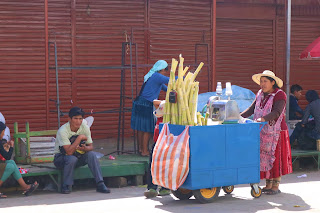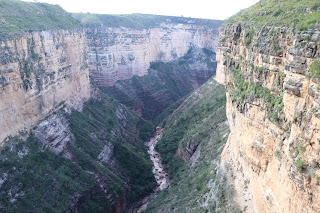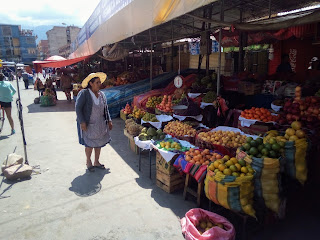Alleyway at Sucre
Our
first day in Sucre was a non-starter, literally. We jumped into Lucy with the intention of
going to see some dinosaur footprints, pressed the starter and nothing
happened. Nothing continued to happen on
subsequent attempts, so we called for an electro-mechanic who turned up on a
rather scruffy motor bike with his baseball cap back to front and the legend
‘Dope’ written in bold letters across it.
This was not a good start, but he got Lucy going, basically with a long
piece of bent wire which he prodded around with inside the engine compartment. Whilst the engine did start, it would not
start on the starter key because the immobiliser, living up to its name, had
immobilised everything and refused to be immobilised itself.
The
Dope accompanied Alan to a garage where he managed to have a light bulb moment
and work out why the immobiliser had refused to deactivate, and the motor
finally started with the key.
The
next day we did manage to visit the Dinosaur footprints, definitely the
highlight of our visit to Sucre. These
footprints, laid down 70 million years ago, are on a huge slab of sandstone
which is almost vertical. This was
originally a muddy beach on the side of a lake until the Andes started to rise,
eventually bringing it up to where it is today.
Up this slab are thousands of dinosaur prints and tracks, the likes of
which we have never seen before and this is, in fact, the biggest known
collection of dinosaur footprints in the world.
Dinosaur footprints, Cal Orko, Sucre
Dinosaur footprints walking to oblivion
Dinosaur footprints
Small person next to large dinosaur footprints
Alan next to dinosaur footprints
What
is really upsetting is that there is no conservation of the site whatsoever, so
the rock is degenerating. Ten years ago,
a huge triangular section which contained by far the best prints that had ever
been recorded fell down and is now completely lost to humanity. Alan felt so strongly about it that he has
since written a stiff little note to UNESCO, signed Disgusted of Bratton!
After
Sucre we headed north to the large city of Cochabamba, a journey which took us
two full days, but we were rewarded once again with the beautiful mountain
scenery.
On the road to Cochabamba
Morning Glory by the roadside
Morning Glory close up
We stopped
off for the night at a strange little town called Aiquile. It was strange because it is the first place
we have come to in our travels where people have completely ignored us. They were not actually rude, they just
behaved as though they would prefer that we weren’t there and sort of looked
through us. Nobody smiled or greeted us,
and we decided that the population could only be described as miserable.
Canyon on the road to Cochabamba
Lakeside lunch stop
As we
approached Cochabamba, we came to a grinding halt somewhere to the south of the
city because the road that we were taking went straight through the
market. The market went on for about a
mile, people were weaving in and out of vehicles, women pushing trolleys with
cold drinks, women carrying babies on their back, men and women with peanut
stalls and coca stalls and stalls selling agricultural implements and plastic
chairs and all the paraphernalia of a South American market. It was fascinating and Alan, of course, took
advantage of the situation with a few clandestine shots of the locals from the
inside of the car.
Campesina selling sugar cane, Cochabamba Market
Street vendor
Chicken buses at Cochabamba market
Street vendor with infant (not for sale)
Campesinas at the market
One of
Cochabamba’s most popular attractions is the Cristo de la Concordia which
stands on top of a very high hill. This
is a figure of Christ with his arms outstretched, modelled on the one at Rio de
Janeiro but, as the locals will tell you, this one is 40m high and thus the
tallest statue in South America. It
weighs over 2,000 tons and it sticks out like a sore thumb.
Did I ever tell you about the Sea Trout I caught? It was this big!
We
decided to go and have a look by taking the modern cable car that makes the
journey up the Serrania de San Pedro hill in five minutes but, of course, it
was closed. Now, there are 1,430 steps
to get to the top of this hill and we got fairly monumentally pooped in the
process. When we finally reached the top,
we were rewarded with an absolutely amazing 360 degree view of Cochabamba and
the surrounding countryside.
View of Cochabamba from the Mirador at the top
View of Cochabamba from the Mirador
Children chasing bubbles at the top
The
drive from Cochabamba to Torotoro on 2nd April was interesting. To begin with we went through some fairly
gentle countryside with little villages, then we came out near the top of a
mighty gorge where we had our picnic lunch looking out over a wide river
valley. Thereafter we were rewarded by
some stunning scenery, great crimson and green cliffs, rock formations and wide
rushing rivers.
The
road itself is currently being renewed, in fact they’re building a new
road. This being the case, the old road
which is quite a nice little road made of cobbles was only occasionally
available and the lovely wide new smooth road was hardly available at all. What we had were muddy diversions which went
uphill and down dale, through splashes, and round impossible hairpins.
Sometimes there were signs telling you that there was a hairpin when it was
perfectly obvious that there was a hairpin and when the road suddenly
disappeared down a sixty degree slope, they didn’t tell you anything, they
allowed you to find out for yourself.
So, this was all a great entertainment along with the big trucks kicking
up smoke and fumes, only rivalled by Lucy who does her bit in that regard. So, our 130 km journey was made rather longer
and certainly a great deal slower than it would otherwise have been, 6 hours in
total.
Lunch stop on the road to Torotoro
On the road to Torotoro
Donkey, Torotoro village
Mother and child, Torotoro village
Street scene, Torotoro village
Toddler with doll, Torotoro
Street scene, Torotoro
Next day was a gentle introduction to the Torotoro National Park. In the morning we went along to the Tourist Information, paid the park entrance fee and arranged for a guide, a compulsory requirement. After lunch we picked up Daniel, our very diddy but lovely guide and he took us first of all to see some dinosaur footprints, of which there were many.
Sue's hand next to dinosaur footprint
Dinosaur tracks
Footprint of carnivorous dinosaur
Sue next to great big dinosaur footprints
Then
we all trundled off to the upper reaches of the Torotoro Gorge where we saw the
‘theatre’ which is a sort of round waterfall, although without much water, and other rock formations. Following the course of the river we eventually
emerged at the top of the mighty Torotoro Canyon where the river plunges down.
The 'Theatre', Torotoro National Park
Naturally formed bridge, known locally as the Bridge of Love
It was
here that we saw the rare and beautiful Red-Fronted Macaws, found only in this
particular region of Bolivia. Alan spent
quite a long time trying to photograph them with limited success as they were
quite far away, even for the Telephoto lens. Thereafter we went and stood in
awe in front of the beautiful spectacle of the canyon.
The
following day was not gentle. In fact,
it was the most strenuous and challenging day that either of us has experienced
for some considerable time. We collected
Daniel at 7.30 am and then drove for about an hour and a half further up into the
Andes to an area called Ciudad de Itas.
Here, at an altitude of 3,400 metres we walked, scrambled and climbed
for two hours to see some beautiful shallow caves and rock formations. We also saw a pair of Condors soaring
majestically overhead, and several Chinchillas sitting on bare bits of rock
ledge.
Endangered Red-Fronted Macaws
Red Fronted Macaws
Torotoro Canyon
Torotoro Canyon
Rock formations, Torotoro National Park
Lucy dwarfed by boulders, Torotoro National park
Andean shepherdess with flock
The 'Cathedral' at Ciudad de Itas
Inside the Cathedral
Giant Turtle rock formation
Sue in awe of the Cathedral
Sue and Diddy Daniel, our guide
Sue and Alan in the Cathedral
The route was not always obvious
Rock formation at the top
Flock of sheep with shepherdesses
We had
the same arduous journey back from Torotoro to Cochabamba where we have
re-installed ourselves in our opulent suite and are enjoying a couple of days
well earned R & R. Today, Sunday 7th April, is the day
when the City Fathers of Cochabamba have decreed that there is no vehicular
traffic allowed in the city and what a wonderful idea that is. Apparently, this happens once every three
months.
The
roads were absolutely full of people, people walking, having fun runs, cycling,
youngsters on roller skates or skateboards, toddlers on plastic tractors with
pedals and the whole place took on a holiday atmosphere. The market area was also thronged with
people, with hundreds of stalls selling everything you can think of. It makes you wonder why we don’t try that in
some of our congested cities in the UK.
Elderly lady, Cochabamba Market
Campesina fruit vendor, Cochabamba Market
Fruit seller
Display of Fruit
Street barbeque
Carnival atmosphere on Cochabamba's vehicle free day
Tomorrow
the roads will be open again and we hope to head off in the direction of La Paz
and Lake Titicaca.























































No comments:
Post a Comment